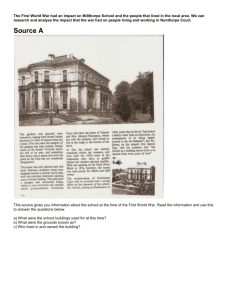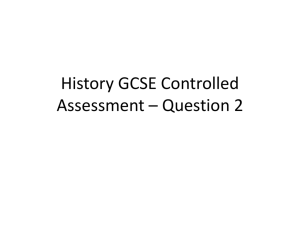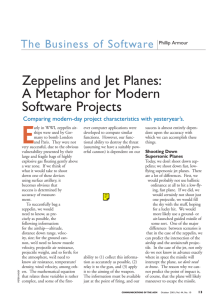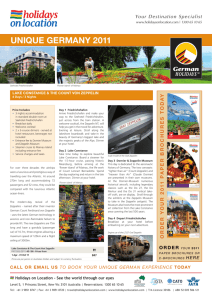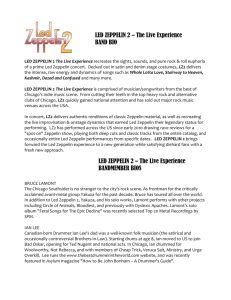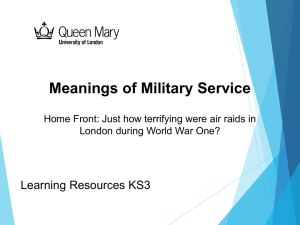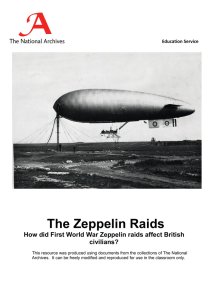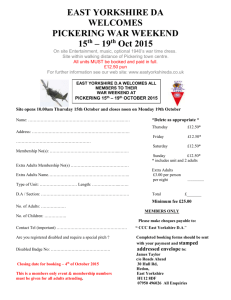WW1 Airship Bombing
advertisement
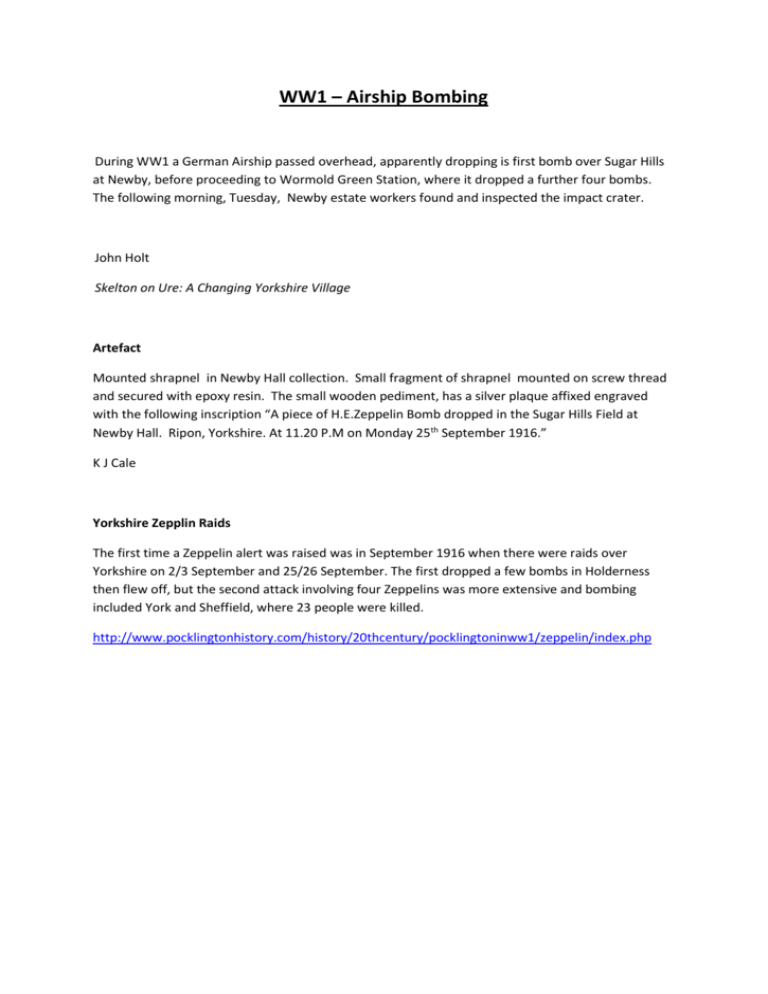
WW1 – Airship Bombing During WW1 a German Airship passed overhead, apparently dropping is first bomb over Sugar Hills at Newby, before proceeding to Wormold Green Station, where it dropped a further four bombs. The following morning, Tuesday, Newby estate workers found and inspected the impact crater. John Holt Skelton on Ure: A Changing Yorkshire Village Artefact Mounted shrapnel in Newby Hall collection. Small fragment of shrapnel mounted on screw thread and secured with epoxy resin. The small wooden pediment, has a silver plaque affixed engraved with the following inscription “A piece of H.E.Zeppelin Bomb dropped in the Sugar Hills Field at Newby Hall. Ripon, Yorkshire. At 11.20 P.M on Monday 25th September 1916.” K J Cale Yorkshire Zepplin Raids The first time a Zeppelin alert was raised was in September 1916 when there were raids over Yorkshire on 2/3 September and 25/26 September. The first dropped a few bombs in Holderness then flew off, but the second attack involving four Zeppelins was more extensive and bombing included York and Sheffield, where 23 people were killed. http://www.pocklingtonhistory.com/history/20thcentury/pocklingtoninww1/zeppelin/index.php Zeppelin Raid on Ripon, Monday, 25th September 1916 Zeppelin raids on Britain began in January 1915 and were initially seen by the British population as a prelude to a German invasion. Throughout the course of the war, Zeppelins carried out a total of 52 raids over Britain, claiming the cost of more than 500 lives from their bombing activities (ref.1). Each Zeppelin was armed with five machine guns and could carry 4400lbs (2oookg) of bombs (ref.2). The use of Zeppelins to carry bombs came at a time when military aviation was still very much in its infancy (the RAF would not be formed until 1918) and the bombing brought the war to the home front for the first time. As a result, civil defence began to be organised in Britain, with blackout conditions beginning to be put into being and enforced by the civil authorities. Initially, it was the police who had the task of ensuring that no lights would be visible to from the air, a precursor to the ARP service in WW2. Zeppelins were very vulnerable to both attack and bad weather, and British pilots and anti-aircraft gunners became adept at shooting them down. Filled with hydrogen gas, they would burst into flames if the gas was ignited by gunfire. A total of 115 zeppelins were used for raids during the war of which 77 were either destroyed or so badly damaged that they were unusable. Because of their losses, the Germans ceased to send Zeppelins over Britain before the end of the war (ref.2). On the night of Monday, 25th September 1916 seven Zeppelins raided Britain, including Yorkshire. The initial report in the Harrogate press was very brief, reproducing a report from London the following day: ‘Official- Seven airships engaged in last night’s raid. Districts attacked were South-east and Northeast coasts and North Midlands. No damage of military importance. Twenty-nine deaths reported’. (ref.3). This was subsequently expanded in the same issue of the newspaper to describe the raids in more detail , but without any mention of Yorkshire. The editor at that time, Mr W.H. Breare, was accustomed to send an open letter to men from the area serving in the armed forces, to update them of local events. In the same edition, he finishes his letter by describing the raid as experienced in Harrogate: ‘On Monday night last, soon after half-past ten, the signal came, ‘Lights out’. There followed a long period of waiting. About 12.30 we heard what we supposed to be the distant sound of a Zeppelin; then explosions, but many of us were in doubt whether they were bombs or shots from the antiaircraft guns. You will be glad to know they did not come too near us. Many people were out in the streets. A number thought they saw something but at such times imagination is active. There were innumerable aeroplanes of ours about. Many people found significance in clouds passing over stars.’ (ref.3). Five Zeppelins seem to have flown over Yorkshire that night and both York and Sheffield were bombed, with 23 people being killed. Decoy fires were lit on Barmby Common to save York Minster and the sound of the Zeppelin engines so alarmed the residents of Pockington that they asked the headmaster of a local school to quieten the choir, in case their voices should act as a guide to the German crew (ref.4). At Ripon, 76 Squadron had just been formed (on 15 September) and were based on the site of the racecourse on Boroughbridge Road, with flights also stationed at Copmanthorpe, Catterick and Helperby (ref.6). Their role was one of home defence, to protect industrial areas against German attack but there is no indication in the records that their obsolete aircraft engaged the enemy on this occasion. Night flying, like aerial warfare, was still in its infancy. Bombs were dropped that night near Ripon and although no damage was done, the event was recalled many years later by a local resident who had been a young girl at the time and living with her parents on the Newby estate (ref.5). Seventy four years on, this unnamed resident recalled that, on September 17th 1916 at approximately 6.30pm, a Zeppelin flew very low over Newby, heading up the river Ure. A swastika and the number ‘174’ were clearly visible on the side of the airship before it was obscured by trees, this latter point emphasising its low height. On that occasion, no bombs were dropped. A week later, a Zeppelin returned to the area and at 11.20pm on Monday 25th September, she heard three heavy thuds, apparently unnoticed by anyone else, even by the army camp less than a mile away in Ripon. The next Thursday, her mother took her to Sugar Fields where they found two large craters, one about twenty feet in diameter, close to the river. There was no trace of the third bomb and she speculated that it may have fallen in the river. The police were informed and men from the locally-based Royal Signals came to investigate but made little of it. Local children doing their own digging did find fragments of metal and a screw cap and it was sufficient of an event for sight-seers to visit at the weekend. On the night of 25/26 September 1916, a Zeppelin bombed Harewood House. Andrew Stokell of Leeds University has written a book about this, obtaining much info from the Zeppelin Museum at Friederichshafen and the National Archives at Washington DC, The Americans having apparently seized German naval records. I suppose these sources are beyond our means although the book may itself be worth getting hold of. It is titled 'Target Leeds: The Attack by Zeppelin L14'. References 1. 2. 3. 4. 5. 6. www.historyonthenet.com/WW1/zeppelin-raids.htm www.spartacus.schoolnet.co.uk/FWWzepeelinraids.htm Harrogate Herald 27 September 1916 www.pockilingtonhistory.com Ripon Gazette 22 June 1990 Bruce B. Halfpenny: Action Stations 4, Military Airfields of Yorkshire 1990 Kevin Earl Claro Community Archaeology Group 2013

